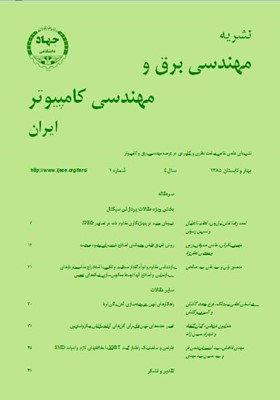تغيير دهندههاي نوين فاز براي آنتنهاي آرايه بازتابي ميكرواستريپي
محورهای موضوعی : electrical and computer engineeringهمایون عریضی 1 , کیان کیقباد 2 * , شهرام حسینزاده 3
1 - دانشگاه علم و صنعت ایران
2 - دانشگاه علم و صنعت ايران
3 - دانشگاه تربيت معلم آذربايجان
کلید واژه: آرايه بازتابيتغيير دهنده فازخم ميكرواستريپاتصال T نامتقارنروش كمترين مربعات,
چکیده مقاله :
يك روش ساده رايج براي توليد اختلاف فاز ميان عناصر آرايه بازتابي ميكرواستريپي ، استفاده از شاخكهاي مدار باز متصل به هر عنصر است. استاب يكنواخت ساده، باند باريك است و پهناي باند آرايه بازتابي را محدود میكند. در اين مقاله دو مدار نوين تغيير دهنده فاز جهت افزايش پهناي باند آرايه بازتابي معرفي شده است. اين مدارها از خطوط انتقال، شاخكهاي انتها باز و مقاومت تشكيل شدهاند. الگوريتم نويني براي طراحي تغييردهندههاي فاز بر اساس روش كمترين مربعات پيشنهاد شده است. يك تابع خطاي كمترين مربعات براي تغيير فاز مورد نياز تشكيل شده است و امپدانس مشخصه و طول الكتريكي خطوط انتقال و اندازه مقاومتها با كمينه سازي اين تابع خطا به دست میآيد. سپس، مدار مذكور با خطوط ميكرواستريپي كه به پچهاي ميكرواستريپي متصل هستند تحقق میيابد. نشان داده میشود كه اين تغيير دهندههاي نوين فاز، تغيير فاز مورد نياز را در پهناي باندي ايجاد میكنند كه نسبت به پهناي باند شاخك يكنواخت بيشتر است. پاسخ فركانسي تغييردهندههاي فاز ميكرواستريپي با نتايجي كه به وسيله نرمافزار Microwave Office به دست آمده مقايسه میشود.
A popular method for creating required phase shifts for patches in a microstrip reflectarray uses open ended stubs attached to the patches. Uniform stubs are narrowband and hence limit the bandwidth of the array. In this paper, two novel methods for designing broadband reactive phase shifters are proposed based on the method of least squares. A structure The frequency response of s to be attached to theA popular method for creating required phase shifts for patches in a microstrip reflectarray uses open ended stubs attached to the patches. Uniform stubs are narrowband and hence limit the bandwidth of the array. In this paper, two novel methods for designing broadband reactive phase shifters are proposed based on the method of least squares. A structure consisting of transmission line sections, open-ended stubs, and resistors is considered for the phase shifter. Another one consists of transmission lines and open-ended. A least square error function is constructed for the required phase shift and the characteristic impedances, electrical lengths of transmission lines and resistances are obtained by its minimization. Then, the circuit is realized by microstrip lines to be attached to the microstrip patch. It is shown that the novel phase shifters create the required phase shifts in a broader bandwidth than those of uniform stub phase shifters. The frequency response of proposed microstrip line phase shifters are validated by the results obtained using AWR's Microwave Office software.
[1] R. C. Hansen, Microwave Scanable Antennas, Academic Press, 1966.
[2] J. Huang, "Microstrip reflectarray and its applications," in Proc. ISAP 96, pp. 1177-1180, Chiba, Japan, 1996.
[3] D. M. Pozar, S. D. Targonski, and H. D. Syrigos, "Design of millimeter wave microstrip reflectarrays," IEEE Trans. on Antennas Propagate, vol. 45, no. 2, pp. 287-296, Feb. 1996
[4] J. Huang and R. J. Pogorzelski, "A Ka-band microstrip reflectarray with elements having variable rotation angles," IEEE Trans. of Antennas Propagation, vol. 46, no. 5, pp. 650-656, May 1998.
[5] M. R. Chaharmir., J. Shaker, M. Cuhaci, and A. Sebak "Reflectarray with slots of varying length on ground plane," in Proc. IEEE Antennas and Propagation Society Int. Symp., vol. 3, pp. 144-147, 2002.
[6] R. D. Javor, X. D. Wu, and K. C., "Design and performance of a microstrip reflectarray antenna," IEEE Trans. on Antennas and Propagation, vol. 43, no. 9, pp. 932-939, Sep. 1995.
[7] A. Van de Capelle, Transmission Line Model for Rectangular Microstrip Antennas, Microstrip Antenna Handbook. London, U. K.: Peter Peregrinus, 1989, Ch. 10.
[8] D. M. Pozar, Microwave Engineering, Addison-Wesely Publishing Company, second edition, 1998.
[9] H. Oraizi and K. Keyghobad, "Novel broadband phase shifter for microstrip reflectarray antennas," in Proc IST 2005, vol. 1, pp. 435-439, Shiraz, Iran, 10-12 Sep. 2005.
[10] T. C. Edwards, Foundations for Microstrip Circuit Design, John Wiley & Sons, second edition, 1992.
[11] P. Anders and F. Amdt, "Microstrip discontinuity capacitances and inductances for double steps, mitered with arbitrary angle and asymmetric right-angle bends," IEEE Trans. on Microwave Theory and Techniques, vol. 28, no. 11, pp. 1213-1217, Nov. 1980.
[12] E. Hammerstad, "Computer-aided design of microstrip couplers with accurate discontinuity models," in Proc MTT-S Int. Microwave Symposium Digest, vol. 81, no. 1, pp. 54-56, Jun. 1981.
[13] http://www.mathworks.com
[14] http://www.appwave.com
[15] P. Bhartia, K. V. S. Rao, and R. S. Tomar, Millimeter-Wave Microstrip and Printed Circuit Antennas, Artech House Inc., 1991.

